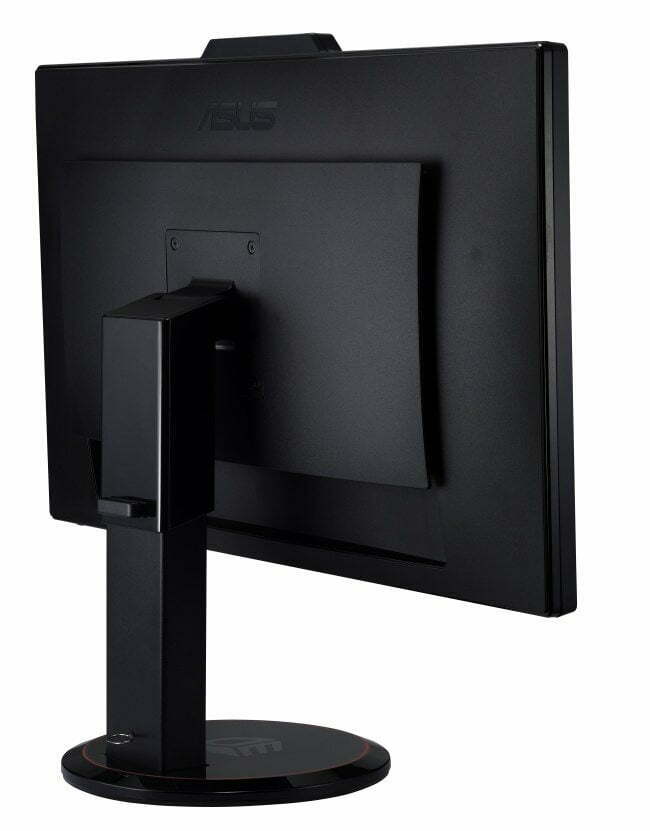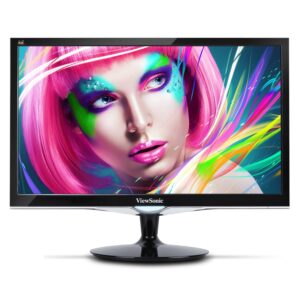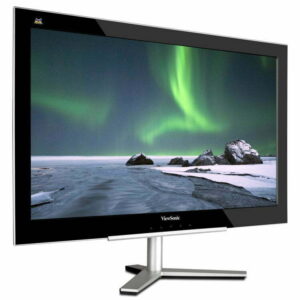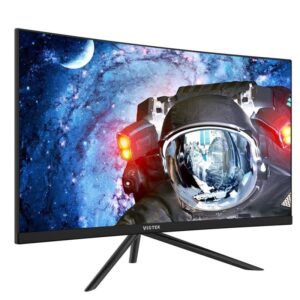
3D displays have been pretty good over the past few years, though they are still rare. The first sets only released three years ago, and every year since has only seen two or three new models. In late 2011 ASUS released the first 27″ 3D monitor, the VG278H, which is the best thing for 3D. The only way to really improve the quality of your 3D gaming at home is to increase the size of your screen. For gamers, the Acer Predator Z301C – top computer monitors for gaming may be what you want. But, based on the ASUS VG278H 3D monitor review the VG278H 3D is still one best computer monitors for gaming despite having some obvious pain points.
As far as monitors go, aside from built-in 3D Vision support, the VG278H is pretty bland. It has high-end specs like 400cd/m2 brightness, 120Hz refresh rate, internal speakers and a 2ms grey-to-grey response time, but that’s all powering a 1920×1080 resolution. For a 27″ panel, that’s pretty low, and it’s noticeable, especially if like me you have at least one other monitor. And, that monitor is an ASUS XG248Q with a 240Hz refresh rate and Nvidia G-Sync technology all packed in a sleek 24″ size. It certainly compliments the VG278H. Now, let’s take an organized look at the display.
Hardware
As mentioned, this ASUS is a high-end gaming display. Response times are fast, the screen gets deathly bright, and the speakers are pretty good to boot. Not as good as the Playstation 3D Display’s, mostly from muffled bass and some tinny highs, but otherwise good.

Let’s talk about screen resolution. Today, widescreen (16:9) is the standard for most PC displays, though few still sell as 16:10. My opinion on the matter is that 16:10 is better, and that if you’re going to have multiple displays, the best way to do it is to have them side by side vertically, so you get a 3600×1920 display, instead of 5760×1200. That’s just more sensical to me, and if that’s the case, why is it any different with two monitors? Especially for gaming.
That said, at 27″ most displays in the past have bumped up the resolution to 2560×1600 or 2560×1440, depending on the aspect ratio. The VG278H does neither, and likely for two reasons: reduced cost and less stressful for gaming. Because of how hard processing 3D is (or rather, how it basically requires twice the graphics computing power because it’s doubling the image), running a game in 3D is already twice as hard. Upping the display from 1080p, or even 1200p, to (in this widescreen case) 2560×1440 is a big step, one most gamers don’t go to.
Another display to look at for high resolution is the Asus Designo Curve MX38VC. Coupled with a 178-degree viewing angle and fast refresh rate, it definitely can be called one of the best curved, widescreen gaming monitors. And, it pairs nicely with the ASUS VG278H.
There is an unwritten expectation from screen sizes, one that ASUS is disrupting under the guise of 3D. Acer will release their own 27″ 3D display as well, also 1080p. I don’t like this decrease in pixel density. It only works if players sit farther away from the display, and in this case, that doesn’t happen. I’ve tested a number of games in 3D (with more write-ups, like Skyrim, to come), and yes, sometimes pixels are visible. They’re more visible when not in-game, and impossible when playing in 3D, but dropping to 1080p isn’t progress. Keep the stupid widescreen, but leave the resolution where it belongs. If you prefer, I found an alternative 27″ screen with 1440p resolution, the Viotek Gn27D review.

The VG278H has an HDMI 1.4, Dual-DVI and VGA port, as well as audio in and audio out. Menu navigation is conducted through four buttons, plus a preset button and power button. The buttons are all easy to press, but not nearly as simple as the touch-sensitive buttons on BenQ’s XL2420TX or Dell’s Alienware OptX from two years ago. There’s also a dedicated display switch between HDMI, DVI and VGA.
Finally, there’s the Vision 2 built-in IR transceiver, which sits at the very top of the relatively small bezel. It’s adjustable to about 40 degrees, which is very convenient for gamers who like to kick back and stay below the monitor.
Related: Read our Acer Monitor H236HL review.
Color Reproduction and 3D
I’ve tested the VG278H in a number of ways, including picture editing, vision-based benchmarks, everyday use, and gaming. Out of the box, the VG278H is pretty accurate, and required minimal adjustment and calibration. As mentioned, the display gets uncomfortably bright, which is especially good for games. I tested all of Skyrim on the VG278H and even with Lightboost (built into the monitor) not active, at max brightness the active shutter glasses couldn’t drown out that much light. After 30 minutes my eyes were watering.
Video and game quality is great, but would be better if the display were glossy. Glossy screens are troublesome for a few reasons, mostly that they are highly reflective. I thought it might be a problem, especially while wearing reflective glasses, but as I found with both the Playstation 3D Display and the VG278H, that’s not the case. 3D gaming on the VG278H during daytime, however, was infinitely easier than on Sony’s display.
The built-in presets are also very well calibrated for their intended uses. Theater Mode is bright but manages colors very well except for a slight green hue (especially in darks), while game mode has slightly higher color saturation and vibrancy. With Skyrim, though there isn’t such incredible color in the game, the VG278H did help bring the world to life with color oversaturation and incredible brightness. And, of course, 3D and the larger 27″ size.

Though in my rant above about regressing in screen density, with the VG278H I was able to really sit back and chill out while 3D gaming. The 22″ displays are too small and 24″ screens are big, but not enough to kick back with a gamepad. The 27″ is big enough to pull that office chair lever and lean back after a hard day’s work. That extra distance, of course, makes it more difficult to notice the lower screen density.
3D quality is also very solid, though that’s more of a software issue versus hardware. I noticed no screen slowdown when playing in 3D (except for occasional graphical hiccups, from the GPU strain). Built-in Lightboost is convenient, though I only found it helpful when playing in a room with plenty of sunlight.
The real benefit of the VG278H over other 3D displays specifically for 3D is the adjustable 3D Emitter. The 20 degrees of rotation is a huge improvement over the standalone emitter, which has to be set for however you’re sitting. For players like me who change how they sit based on the game, mood, or time of day, that’s a lot of hassle gone out the window.
Conclusion
For the retail price of $680 (available for as low as $620), including one set of 3D Vision 2 glasses (retail $150, available for around $70), the VG278H is an expensive panel, even at the lower prices. Then again, I haven’t found a single 3D display that can provide the same high-quality 3D gaming. There simply isn’t one. BenQ’s offering is still a 24″ panel, and we’ll have to wait and see how Acer’s upcoming 27″ competitor stacks up. But considering their last penny-pinching display, it may save on price but skimp out on quality. We’ll have to wait and see.
Right now, there is no better 3D display than the ASUS VG278H. It provides excellent picture quality straight out of the box, is easy to use, and provides almost all of the amenities one can hope for in a monitor. For the price, I’d have expected touch-sensitive buttons and a better swivel stand, which while adjustable tends to turn the whole stand instead of just the screen.
Editor’s Rating:
[Rating: 4]
Great
Bottom Line: Excellent picture quality right out of the box. Very bright, very big, and with a built-in 3D emitter, very convenient.
Pros:
- Great picture quality
- Very bright, even in sunlight
- Larger size makes 3D gaming way more fun
- Swivel 3D emitter is a gift from the heavens
- Slight green hue to darks
- 1080p resolution for a 27″ display…that’s going backwards
- Expensive, even with a set of 3D Vision 2’s
Related Articles:








![Best 4K Gaming Monitor in [year] ([month] Reviews) 9 The 4k Gaming Monitors|||#1 Best 4K Gaming Monitor|#3 Best 4K Gaming Monitor|#2 Best 4K Gaming Monitor|Best 4K Gaming Monitor|||](https://www.gadgetreview.dev/wp-content/uploads/best-4k-gaming-monitor-300x169.jpg)
![Best External Monitor in [year] ([month] Reviews) 10 Best External Monitors](https://www.gadgetreview.dev/wp-content/uploads/best-external-monitors-300x200.jpg)
![Best Monitor For Video Editing in [year] ([month] Reviews) 11 Asus GV245H PS4 Monitor](https://www.gadgetreview.dev/wp-content/uploads/asus-gv245h-300x247.jpg)
![Best Monitor Stand in [year] ([month] Reviews) 12 Best Monitor Stands](https://www.gadgetreview.dev/wp-content/uploads/best-monitor-stands-300x180.jpg)













